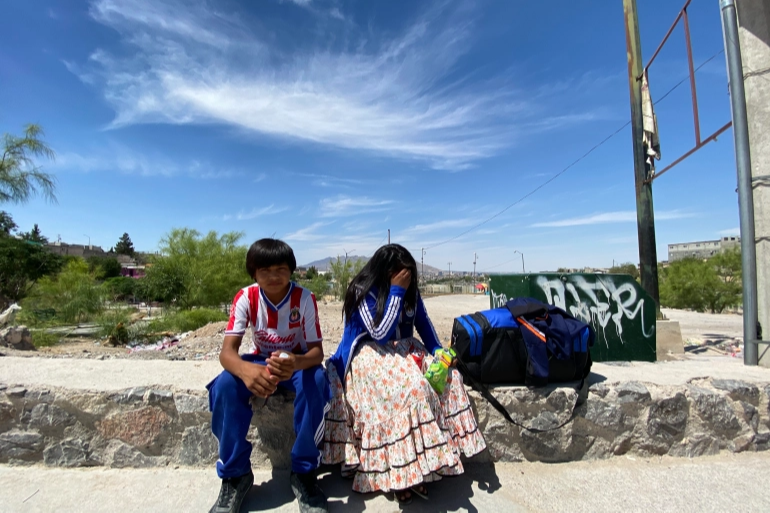
Two Raramuri adolescents wait for a bus to go back to their home villages in the Sierra Tarahumara [Luis Chaparro/Al Jazeera]
Ciudad Juarez, July 4 (RHC)-- For Claudia, the journey from her small Guatemalan village in Guatemala to the US-Mexico border was complicated by the fact she could speak only her native Ixil, one of 21 Mayan languages in Guatemala.
On way to what she had hoped would be asylum in the United States, she communicated with the smugglers with hand gestures and the few words of Spanish she knew, to ask for water, food, money, and to go to the toilet.
Claudia and her four-year-old son Manuel arrived at the U.S. border at the end of December 2020. Her smugglers dropped them off at a highway right next to the Rio Grande and told her to walk past the dry river and turn herself in to the U.S. Border Patrol. Claudia did not want her last name published for fear of reprisals.
She said the Border Patrol agents took photos, fingerprinted them both and sent them back to the Mexican border city Ciudad Juarez the same day. If they gave her any instructions, she did not understand them.
After eight months at the El Buen Samaritano shelter in Ciudad Juarez, Claudia has begun to speak some Spanish, but not enough to ensure she understands what’s happening with her immigration case, or what she should be doing.
“I understand more Spanish than I can speak. I try to tell everyone that I understand what they are telling me, but sometimes, it is hard for me to communicate, to ask some questions” she told Al Jazeera in halting Spanish.
Claudia and the dozens like her who do not speak a mainstream language, such as Spanish or Portuguese, can languish at the US-Mexico border for months or years, because there are few or no interpreters that speak their Indigenous language to help them navigate the immigration and asylum systems.
Shelter director Juan Fierro said Claudia will likely have to wait a long time before she can apply for asylum. “We have reached out to international aid organisations to try and find an Ixil interpreter because without one she won’t be processed” through the US system, Fierro told Al Jazeera.
Almost all of the 500 asylum seekers hosted at Fierro’s shelter from January to June 2021 have left to pursue claims inside the US after waiting between six to 12 months. Only those recently expelled back to Mexico and Claudia remain.
Fierro has hosted more than 50 non-Spanish speaking migrants and asylum seekers, mostly speaking only Mayan languages in the first half of 2021 alone – almost double from all of 2020.
}“Most of them get tired of waiting for an interpreter and leave to go back to their hometowns. Only very few wait long enough to get an interpreter and start their immigration process”, Fierro said.
This year, the number of migrants and asylum seekers from small villages speaking only their traditional languages apprehended at the border almost doubled, creating a long backlog for the immigration legal system.
Amiena Khan, president of the National Association of Immigration Judges, said most cases regarding Indigenous language speakers are now being rescheduled because of a lack of trained interpreters. “The problem we are seeing is that in our community there are too few Indigenous interpreters, especially for Mayan languages and cases are being rescheduled to where a judge can be confident that they get a proper interpreter”, Khan told Al Jazeera.
The U.S. immigration court system already has more than 1.3 million backlogged cases, according to the Transactional Records Access Clearinghouse (TRAC) at Syracuse University. At least 40 different languages are spoken by the nearly 30,000 migrants who had pending cases as of January, 2021 according to data obtained by TRAC.
“Although Indigenous and other rare languages make up a small number of pending MPP cases—just 337 out of 29,423—the need for language access presents unique challenges for both migrants and the Immigration Courts," according to an April 26 TRAC report.
It is difficult to calculate how many migrants with rare languages could be in or about to enter the immigration system. Given past numbers, speakers of Indigenous languages could amount to less than 1 percent of the total, but that is dozens or hundreds who could end up in a limbo of sorts.
“These cases will not come to us until December 2023, this means we already have a backlog, and that’s on top of whatever time it takes to find interpreters for most of the Indigenous community on an immigration process”, said Khan.
Odilia Romero, an independent interpreter of the Indigenous Zapotec language and co-founder of Comunidades Indigenas en Liderazgo (CIELO), said many of the interpreters aiding US courts do not have the skills to represent migrants at official hearings.
“The few interpreters at U.S. courts are not educated or trained to properly translate for Indigenous immigrants. They are either gardeners or local workers who migrated from the same communities, but that doesn’t mean they know how to properly translate for a U.S. immigration court,” Romero said.
Even if asylum seekers like Claudia end up in court, after a long wait for a translator, there’s no guarantee they will be able to clearly communicate their case for asylum. “This is not only leaving Indigenous immigrants at the very end of immigration courts but also violating a basic human right,” said Romero.
Claudia at the shelter said going back to Guatemala is not an option. “I’ll wait, as long as I have to. I can’t go back to Guatemala, there is a reason why I left, otherwise I would have stayed there”, she said.´

